
Open Access
Available online http://ccforum.com/content/11/4/R84
Page 1 of 11
(page number not for citation purposes)
Vol 11 No 4
Research
Urine neutrophil gelatinase-associated lipocalin is an early
marker of acute kidney injury in critically ill children: a prospective
cohort study
Michael Zappitelli1*, Kimberly K Washburn1*, Ayse A Arikan1, Laura Loftis1, Qing Ma2,
Prasad Devarajan2, Chirag R Parikh3 and Stuart L Goldstein1
1Texas Children's Hospital, Fannin Street, Houston, Texas 77030, USA
2Cincinnati Children's Hospital Medical Center, Burnet Avenue, Cincinnati, Ohio 45229-3039, USA
3Yale University School of Medicine, Campbell Avenue, West Haven, Connecticut 06516, USA
* Contributed equally
Corresponding author: Stuart L Goldstein, stuartg@bcm.tmc.edu
Received: 20 Apr 2007 Revisions requested: 16 May 2007 Revisions received: 23 May 2007 Accepted: 2 Aug 2007 Published: 2 Aug 2007
Critical Care 2007, 11:R84 (doi:10.1186/cc6089)
This article is online at: http://ccforum.com/content/11/4/R84
© 2007 Zappitelli et al.; licensee BioMed Central Ltd.
This is an open access article distributed under the terms of the Creative Commons Attribution License (http://creativecommons.org/licenses/by/2.0),
which permits unrestricted use, distribution, and reproduction in any medium, provided the original work is properly cited.
Abstract
Introduction Serum creatinine is a late marker of acute kidney
injury (AKI). Urine neutrophil gelatinase-associated lipocalin
(uNGAL) is an early marker of AKI, where the timing of kidney
injury is known. It is unknown whether uNGAL predicts AKI in
the general critical care setting. We assessed the ability of
uNGAL to predict AKI development and severity in critically ill
children.
Methods This was a prospective cohort study of critically ill
children. Children aged between 1 month and 21 years who
were mechanically ventilated and had a bladder catheter
inserted were eligible. Patients with end-stage renal disease or
who had just undergone kidney transplantation were excluded.
Patients were enrolled within 24 to 48 hours of initiation of
mechanical ventilation. Clinical data and serum creatinine were
collected daily for up to 14 days from enrollment, and urine was
collected once daily for up to 4 days for uNGAL measurement.
AKI was graded using pRIFLE (pediatric modified Risk, Injury,
Failure, Loss, End Stage Kidney Disease) criteria. Day 0 was
defined as the day on which the AKI initially occurred, and
pRIFLEmax was defined as the worst pRIFLE AKI grade
recorded during the study period. The χ2 test was used to
compare associations between categorical variables. Mann-
Whitney and Kruskal-Wallis tests were used to compare
continuous variables between groups. Diagnostic
characteristics were evaluated by calculating sensitivity and
specificity, and constructing receiver operating characteristic
curves.
Results A total of 140 patients (54% boys, mean ± standard
deviation Pediatric Risk of Mortality II score 15.0 ± 8.0, 23%
sepsis) were included. Mean and peak uNGAL concentrations
increased with worsening pRIFLEmax status (P < 0.05). uNGAL
concentrations rose (at least sixfold higher than in controls) in
AKI, 2 days before and after a 50% or greater rise in serum
creatinine, without change in control uNGAL. The parameter
uNGAL was a good diagnostic marker for AKI development
(area under the receiver operating characteristic curve [AUC]
0.78, 95% confidence interval [CI] 0.62 to 0.95) and persistent
AKI for 48 hours or longer (AUC 0.79, 95% CI 0.61 to 0.98), but
not for AKI severity, when it was recorded after a rise in serum
creatinine had occurred (AUC 0.63, 95% CI 0.44 to 0.82).
Conclusion We found uNGAL to be a useful early AKI marker
that predicted development of severe AKI in a heterogeneous
group of patients with unknown timing of kidney injury.
Introduction
Severe acute kidney injury (AKI) increases morbidity and mor-
tality of hospitalized patients [1-3]. Recent evidence suggests
that a small reduction in renal function, indicated by serum cre-
atinine (SCr), is an independent predictor of mortality and
length of hospital stay [1,4]. Laboratory research has revealed
that early intervention may be essential in preventing the
pathophysiologic events that lead to AKI [5,6]. Unfortunately,
SCr – the main AKI biomarker used in the clinical setting – is
a late marker of reduced glomerular filtration rate, which limits
AKI = acute kidney injury; AUC = area under the receiver operating characteristic curve; CI = confidence interval; CPB = cardiopulmonary bypass;
eCCL = estimated creatinine clearance; PICU = pediatric intensive care unit; pRIFLE = pediatric modified Risk, Injury, Failure, Loss, End Stage Kidney
Disease criteria; PRISM = Pediatric Risk of Mortality; SCr = serum creatinine; uNGAL = urine neutrophil gelatinase-associated lipocalin.

Critical Care Vol 11 No 4 Zappitelli et al.
Page 2 of 11
(page number not for citation purposes)
ability to detect AKI early and to initiate clinical therapeutic
studies. Therefore, recent research has focused on identifying
earlier biomarkers of AKI [7-12].
Neutrophil gelatinase-associated lipocalin (NGAL), a ubiqui-
tous 25 kDa protein, was isolated as a potential biomarker of
AKI using genomic microarray technology [12,13]. NGAL is
generally expressed in low concentrations, but it increases
greatly in the presence of epithelial injury and inflammation
[12,14,15]. Mishra and coworkers [16] observed a significant
rise in uNGAL (uNGAL) 2 days before the rise in SCr in chil-
dren with AKI following cardiopulmonary bypass (CPB). These
findings have now been confirmed in a prospective study of
adults who developed AKI after cardiac surgery [17], which
found uNGAL to be significantly elevated by one to three
hours after the operation. Other human studies [18-20] dem-
onstrated a strong relationship between uNGAL and AKI in
renal transplantation, diarrhea-associated hemolytic-uremic
syndrome, and lupus nephritis.
It is unknown whether the association between uNGAL and
AKI can be generalized to the critical care setting, in which the
population is heterogeneous and AKI etiology and timing are
often unclear. Furthermore, the prevalence of sepsis in the
intensive care unit (ICU) may limit the use of uNGAL as a spe-
cific biomarker of kidney injury. We studied uNGAL concentra-
tions in a group of critically ill children with the following goals:
to determine whether there is an association between uNGAL
and AKI in this heterogeneous group; to evaluate the effect of
sepsis and illness severity on the use of uNGAL to predict AKI;
to determine the extent to which uNGAL concentrations
increase before SCr in the setting of an unknown timing of ini-
tial kidney injury; and to evaluate the sensitivity and specificity
of uNGAL to predict the clinical course of AKI.
Materials and methods
Study design and subject selection
This study was performed concurrently with a prospective
observational study that validated pRIFLE (pediatric modified
Risk, Injury, Failure, Loss, End Stage Kidney Disease) criteria
for defining AKI in critically ill children [21]. Patients aged 1
month to 21 years, admitted to the pediatric ICU (PICU), who
received mechanical ventilation and underwent indwelling
bladder catheterization, were eligible for enrollment. Patients
with end-stage renal disease and who had just undergone
renal transplantation were excluded. Patient care givers pro-
vided written informed consent for the child to participate in
the descriptive study of AKI and for collection of urine sam-
ples. The study protocol and consent forms were approved by
the Baylor College of Medicine Human Subjects Institutional
Review Board before study initiation.
Clinical data collection
The following clinical variables were evaluated: patient age,
sex, height, and weight; admission and discharge diagnoses;
vasopressor use (yes/no) and number of vasopressors used;
renal replacement therapy provision; and 28-day mortality.
Patients with an admission or discharge diagnoses of sepsis,
septic shock, or systemic inflammatory response syndrome
were classified as having sepsis. The Pediatric Risk of Mortal-
ity (PRISM) II score (a measure of severity of illness/mortality
risk) was calculated on the day of ICU admission [22].
Laboratory data collection
SCr values were obtained prospectively as part of routine
patient care from the day of enrollment up to 14 days of the
study (or until PICU discharge if this occurred before 14 days).
At study completion, SCr values from PICU admission to study
enrollment were recorded retrospectively. Estimated creati-
nine clearance (eCCl) was calculated using the Schwartz for-
mula [23]. Patients were classified daily by pRIFLE criteria for
AKI, using changes in eCCl from baseline eCCl (Table 1).
Each patient's first AKI occurrence using pRIFLE criteria and
the worst pRIFLE status (pRIFLEmax) attained over 14 days
were recorded. Baseline renal function was defined as the
lowest known SCr value during the preceding 3 months.
Patients without known prior SCr were assumed to have nor-
mal baseline renal function and assigned a baseline eCCl of
120 ml/min per 1.73 m2. This cutoff was chosen because the
Schwartz eCCl overestimates glomerular filtration rate. For
those patients with no known baseline SCr and a PICU admis-
sion eCCl greater than 120 ml/min per 1.73 m2, their PICU
admission eCCl was recorded as their baseline renal function.
Urine specimen collection
Urine specimens were collected at 14:00 hours each day, for
up to four consecutive days, beginning on the day of enroll-
ment or the following day if consent was obtained after 14:00
hours (Figure 1a). Reasons for not collecting urine samples on
all four days included bladder catheterization discontinuation,
hospital discharge, death, and anuria. Urine bags were emp-
tied at 13:00 hours to allow collection of fresh urine in the fol-
lowing hour. Anuria was defined as less than 5 ml in the urine
collection bag from the hour before collection, because this
was the minimum amount required for processing and storage.
Urine processing was similar to that in previous studies
[18,19], in order to limit variations in findings resulting from dif-
ferences in sample handling. Urine specimens were kept on
ice until they were centrifuged at 3,000 rpm at 4°C for 5 min.
The supernatant was aliquoted equally into cryovials and
stored at -80°C. Pre-laboratory analysis sample handling
required minimal time and effort (approximately 10 min). De-
Samples were shipped to Cincinnati Children's Hospital Med-
ical Center for uNGAL and creatinine measurement; lab per-
sonnel were blinded as to any patient information and pRIFLE
status. Urine samples were analyzed for NGAL using an
established and validated enzyme-linked immunosorbent
assay [18,19,24]. Microtiter plates were coated overnight at
4°C with a mouse monoclonal antibody directed against

Available online http://ccforum.com/content/11/4/R84
Page 3 of 11
(page number not for citation purposes)
human NGAL (#HYB211-05; AntibodyShop, Gentofte, Den-
mark). All subsequent steps were performed at room temper-
ature. Plates were blocked with buffer containing 1% bovine
serum albumin, coated with 100 μl sample (urine or serum) or
standards (NGAL concentrations ranging from 1 to 1000 ng/
ml), and incubated with a biotinylated monoclonal antibody
directed against human NGAL (#HYB211-01B; Antibody-
Shop) followed by avidin-conjugated horseradish peroxidase
(Dako, Glostrup, Denmark). TMB substrate (BD Biosciences,
San Jose, CA, USA) was added for color development, which
was read after 30 min at 450 nm with a microplate reader
(Benchmark Plus; BioRad, Hercules, CA, USA). Urine creati-
nine was measured using a quantitative colorimetric assay
(Sigma Chemical Co., St. Luois, MO, USA). All measurements
were taken in triplicate. The Cincinnati Children's Hospital
Medical Center laboratory was blinded to the AKI status of
each patient. Final uNGAL values were expressed in nano-
grams per milliliter and nanograms per milligram of creatinine.
Figure 1
Description of urine collection procedures and use of urine specimens with reference to analytic time pointsDescription of urine collection procedures and use of urine specimens with reference to analytic time points. (a) Overall urine collection procedure.
The image shows that study enrollment began shortly after initiation of ventilation and that urine was collected once per day for up to 4 days if possi-
ble. (b) Acute kidney injury (AKI) urine specimens collected before AKI development were used for assessment of urine neutrophil gelatinase-asso-
ciated lipocalin (uNGAL) for early detection of AKI. (c) AKI urine specimens collected within 24 hours of AKI by pRIFLE (pediatric modified Risk,
Injury, Failure, Loss, End Stage Kidney Disease) criteria were used to evaluate uNGAL as a marker of severity of renal injury. day 0, the first day the
patient attained AKI; PICU, pediatric intensive care unit; pRIFLEmax, the worst pRIFLE stratum attained; SCr, serum creatinine; uNGAL, urine neu-
trophil gelatinase-associated lipocalin.

Critical Care Vol 11 No 4 Zappitelli et al.
Page 4 of 11
(page number not for citation purposes)
Secondary exclusion of patients and urine samples
Before statistical analysis of urine samples, patients were fur-
ther excluded from this study if fewer than two SCr values
were available for the duration of the admission (and not
before early death) or if no urine specimens were collected
throughout the study period. If patients had even one urine
specimen collected, they were included.
Data management, interpretation, and analysis
Using all urine specimens available from all patients, the mean
and peak uNGAL concentrations from each patient were tab-
ulated. Mean and peak uNGAL were compared between con-
trol individuals and those with AKI (based on the R, I, and F
components of pRIFLEmax) during admission. The data were
examined for an association between mean or peak uNGAL
and the presence of sepsis, PRISM II scores, and mortality.
For all subsequent analyses, only data from urine samples for
which SCr was known in the 48 hours after urine collection
were used. We first examined whether uNGAL rises before
clinical evidence of AKI becomes apparent, as determined by
pRIFLE criteria. The data were arranged to define 'day 0' as
the first day on which a patient sustained AKI. Urine samples
collected between 72 hours before day 0 (days -3, -2, and -1;
Figure 1b) and 48 hours after day 0 (days 0, +1, and +2) were
compared with control uNGAL concentrations. Up to four con-
trol urine specimens per AKI urine specimen, drawn during the
same day of mechanical ventilation as the AKI patient, were
randomly selected for comparison using a random number
generator. Some control urine specimens are represented
more than once for comparison with different AKI urine
specimens.
The diagnostic characteristics of uNGAL in predicting AKI
were examined. The first urine specimen collected from AKI
patients who had urine collected before AKI development and
the first urine specimen collected from control individuals (Fig-
ure 1b) were used to calculate the sensitivity and specificity of
uNGAL in predicting the onset of AKI during the next 48 hours
and the onset of 'persistent' AKI durinng the next 48 hours.
'Persistent AKI' was defined as lack of complete resolution of
AKI within 48 hours, as a surrogate marker of patients who had
fluid responsive AKI. We only used the first urine specimen
collected from these patients to simulate the collection of urine
for NGAL measurement shortly after becoming 'at risk' (the
day of initiation of mechanical ventilation) but before the devel-
opment of AKI.
Table 1
Pediatric modified pRIFLE criteria for AKI using changes in
estimated creatinine clearance
pRIFLE stratum Change in eCCl
Risk (R) eCCl decrease by 25% from baseline renal
function
Injury (I) eCCl decrease by 50% from baseline renal
function
Failure (F) eCCl decrease by 75% from baseline renal
function or eCCl < 35 ml/min per 1.73 m2
The original pediatric Risk, Injury, Failure, Loss, End Stage Kidney
Disease criteria [21] for acute kidney injury (AKI) also include pRIFLE
L (loss) and pRIFLE E (end stage kidney disease), identifying those
patients who require dialysis for periods longer than 30 days. eCCl,
estimated creatinine clearance; pRIFLE, pediatric modified Risk,
Injury, Failure, Loss, End Stage Kidney Disease.
Table 2
Patient characteristics by pRIFLEmax AKI status
Characteristic Control (n = 34) pRIFLEmax R (n = 50) pRIFLEmax I (n = 31) pRIFLEmax F (n = 25)
Age (years) 8.5 ± 6.2a/8 (11.0) 5.9 ± 6.7/2 (12.4) 4.4 ± 5.7/1 (8.7) 6.6 ± 6.4/4 (11.2)
PRISM II scoreb12.5 ± 7.7/12.5 (10) 14.2 ± 7.9/15 (13) 15.9 ± 7.3/16 (9) 19.0 ± 8.0/19 (12)
Day of admission enrolled (days) 2.8 ± 1.0/3 (1) 2.8 ± 1.1/2.5 (1) 3.3 ± 2.1/3 (2) 3.1 ± 1.7/3 (2)
Day of admission of pRIFLEmax NA 3.6 ± 3.6/2 (4) 2.5 ± 2.6/1 (2) 3.5 ± 4.0/1 (3)
Day of ventilation first urine collection 2.2 ± 0.7/2 (0.5) 2.5 ± 1.1/2 (1) 2.2 ± 0.8/2 (1) 2.3 ± 0.9/2 (1)
Days from day 0 of first urine collectioncNA -0.8 ± 3.7/0 (4) 1.8 ± 2.2/1 (1) 1.7 ± 1.0/2 (1)
Male 18 (52.9) 27 (54.0) 18 (58.1) 12 (48.0)
Sepsis 7 (20.6) 4 (8.0)d12 (38.7) 9 (36.0)
Dialysis 0 0 2 (6.5) 5 (20.0)
30-day mortality 3 (8.8) 4 (8.0) 6 (19.4) 7 (28.0)
Values are expressed as mean ± standard deviation/median (interquartile range) or as n (%). aControl patients were older than those with
pRIFLEmax R and I acute kidney injury (AKI; P < 0.05, Mann-Whitney test). bPediatric Risk of Mortality (PRISM) II score increased progressively
with increasing pRIFLEmax strata (P < 0.05, Kruskal-Wallis test). cNumber of days from the day of AKI attainment that the first of four urine
samples was collected for each patient. dPatients in the pRIFLEmax R group had a lower proportion of sepsis, as compared with those in the
pRIFLEmax I and F groups (both P < 0.05, z-test). pRIFLEmax, the worst pRIFLE stratum attained; pRIFLE, pediatric modified Risk, Injury, Failure,
Loss, End Stage Kidney Disease.

Available online http://ccforum.com/content/11/4/R84
Page 5 of 11
(page number not for citation purposes)
Several patients had their first urine sample collected on the
day of or one day after developing AKI (within 24 hours of the
first detected SCr increase, as shown in Figure 1c). We there-
fore evaluated the utility of uNGAL from day 0 or day +1 to pre-
dict persistent AKI and progression of AKI to a higher
pRIFLEmax stratum in patients who initially satisfied the R cri-
terion of pRIFLE.
Statistical analysis
Urine NGAL was non-normally distributed, and therefore non-
parametric testing was used to compare uNGAL concentra-
tions between groups (Mann-Whitney test for two groups and
Kruskal-Wallis test for multiple groups). Categorical variables
were analyzed using the χ2 test, and proportions were com-
pared using the z-test. Diagnostic characteristics were calcu-
lated using standard 2 × 2 tables, and receiver operating
characteristic curves were constructed. Analyses were per-
formed using the Intercooled STATA® statistical software
package (Stata Corp., College Station, TX, USA). Values
which followed a normal distribution are expressed as mean ±
standard deviation and those which followed a non-normal dis-
tribution are expressed as median [interquartile range].
Results
Patient demographics
A total of 150 patients were enrolled in the AKI study con-
ducted to validate the pRIFLE criteria [21]. Ten patients were
excluded from urinary biomarker studies: five were anuric and
for five fewer than two SCr measurements were available. The
mean age was 6.3 ± 6.4 years (median 3.5 years, range 1
month to 21 years) and mean weight was 24.9 ± 21.5 kg
(median 15.6 kg) for the remaining 140 subjects (75 boys
[54%] and 65 girls [46%]). Nine patients had a baseline eCCl
below 90 ml/min per 1.73 m2; three patients had an eCCl
below 60 ml/min per 1.73 m2. The mean PRISM II score was
15.0 ± 8.0 (median 15). Thirty-two (23%) patients had a diag-
nosis of sepsis and 74 (53%) received vasopressors.
Mean PICU day of enrollment was 3.0 ± 1.5 days (median 3
days, range 1 to 9 days). Eighty-nine per cent of patients were
enrolled on or before PICU day 4. Urine collection began on
PICU day 3.0 ± 1.4 (median day 3) and day of ventilation 2.3
± 0.9 (median day 2).
Thirty-four (24.3%) patients never sustained AKI and served
as control individuals. A total of 106 (75.7%) patients devel-
oped AKI (35.7% [n = 50] satisfied the R criterion in their pRI-
FLEmax, 22.1% [n = 31] satisfied the I criterion in their
pRIFLEmax, and 17.9% [n = 25] satisfied the F criterion in
their pRIFLEmax). Baseline eCCl was similar between control
and AKI patients (median [interquartile range] 119 [38] ml/min
per 1.73 m2 and 129 [87] ml/min per 1.73 m2, respectively; P
> 0.05). For 82% of patients with AKI, urine collections were
available between 72 hrs before and after day 0 of AKI.
Table 2 shows the characteristics of patients in the control
group and for those in each pRIFLEmax stratum (namely, those
satisfying the R, I, and F criteria in the pRIFLEmax for AKI).
Patients in the control group were older than those in the pRI-
FLEmax R and I groups. PRISM II scores increased progres-
sively with worsening pRIFLEmax strata (P < 0.05, Kruskal-
Wallis test), and the combined mortality of patients with pRI-
FLEmax I and F (n = 56) was higher than the combined mor-
tality of control and pRIFLEmax R patients (n = 84; P < 0.05,
z-test).
Association of mean and peak uNGAL concentrations
with pRIFLEmax
All urine specimens were used to calculate mean and peak
uNGAL. A total of 334 urine specimens were obtained from
Table 3
Peak and Mean uNGAL concentrations by pRIFLEmax status
Measurement Control pRIFLEmax R pRIFLEmax I pRIFLEmax F
Mean uNGALa
ng/mg creatinine 0.5 ± 1.5/0.1 (0.2) 0.6 ± 0.9b/0.3 (0.9) 1.7 ± 2.6b/0.7 (1.8) 2.8 ± 3.0b,c/1.5 (4.2)
ng/ml 14.2 ± 27.2/5.3 (13.2) 20.9 ± 28.1/11.6 (27.5) 58.9 ± 86.6b/20 (71.4) 82.7 ± 92.5b,c/35.0 (76.3)
Peak uNGALa
ng/mg creatinine 0.8 ± 2.0/0.2 (0.4) 1.0 ± 1.5b/0.4 (1.2) 2.5 ± 3.8b/0.9 (1.9) 3.8± 3.8b,c/1.8 (5)
ng/ml 24.6 ± 45.5/7.9 (20.0) 34.5 ± 47.4/14.7 (40.5) 82.9 ± 122.9b/25.0 (70.0) 103.2 ± 107.3b,c/55.0 (105.0)
Values are expressed as mean ± standard deviation/median (interquartile range). aMean and peak urine neutrophil gelatinase-associated lipocalin
(uNGAL) concentrations increased with worsening pRIFLEmax acute kidney injury (AKI; all P < 0.0002, Kruskal-Wallis test), whether expressed in
ng/mg creatinine or ng/ml. These relationships were also statistically significant when examined by one-way analysis of variance (P < 0.0001).
bMean and peak uNGAL expressed in ng/mg creatinine was higher in patients with pRIFLEmax R, I and F AKI than in control patients (all P < 0.05,
Mann-Whitney test); mean and peak uNGAL expressed in ng/ml was higher in patients with pRIFLEmax R, I, and F AKI than in control patients (all
P < 0.05, Mann-Whitney test). cMean and peak uNGAL was higher in patients with pRIFLEmax F AKI than in those with pRIFLEmax R and I AKI
(all P < 0.05, Mann-Whitney test), whether expressed in ng/mg creatinine or in ng/ml. pRIFLEmax, the worst pRIFLE stratum attained; pRIFLE,
pediatric modified Risk, Injury, Failure, Loss, End Stage Kidney Disease.

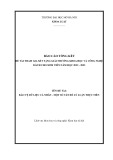
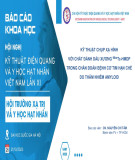

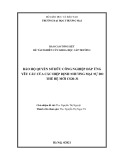
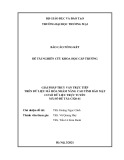
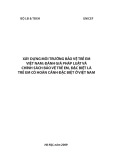
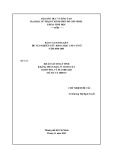
![Vaccine và ứng dụng: Bài tiểu luận [chuẩn SEO]](https://cdn.tailieu.vn/images/document/thumbnail/2016/20160519/3008140018/135x160/652005293.jpg)
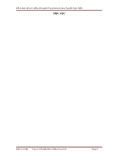
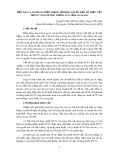





![Báo cáo seminar chuyên ngành Công nghệ hóa học và thực phẩm [Mới nhất]](https://cdn.tailieu.vn/images/document/thumbnail/2025/20250711/hienkelvinzoi@gmail.com/135x160/47051752458701.jpg)









